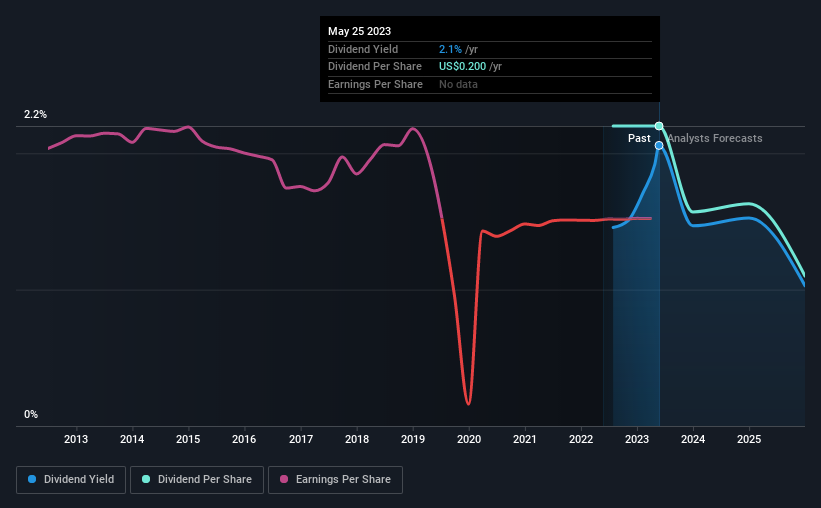Do These 3 Checks Before Buying Dun & Bradstreet Holdings, Inc. (NYSE:DNB) For Its Upcoming Dividend
Regular readers will know that we love our dividends at Simply Wall St, which is why it's exciting to see Dun & Bradstreet Holdings, Inc. (NYSE:DNB) is about to trade ex-dividend in the next 4 days. The ex-dividend date is one business day before a company's record date, which is the date on which the company determines which shareholders are entitled to receive a dividend. The ex-dividend date is an important date to be aware of as any purchase of the stock made on or after this date might mean a late settlement that doesn't show on the record date. Thus, you can purchase Dun & Bradstreet Holdings' shares before the 31st of May in order to receive the dividend, which the company will pay on the 15th of June.
The company's next dividend payment will be US$0.05 per share, on the back of last year when the company paid a total of US$0.20 to shareholders. Based on the last year's worth of payments, Dun & Bradstreet Holdings stock has a trailing yield of around 2.1% on the current share price of $9.72. We love seeing companies pay a dividend, but it's also important to be sure that laying the golden eggs isn't going to kill our golden goose! So we need to investigate whether Dun & Bradstreet Holdings can afford its dividend, and if the dividend could grow.
See our latest analysis for Dun & Bradstreet Holdings
Dividends are typically paid from company earnings. If a company pays more in dividends than it earned in profit, then the dividend could be unsustainable. Dun & Bradstreet Holdings paid a dividend last year despite being unprofitable. This might be a one-off event, but it's not a sustainable state of affairs in the long run. Considering the lack of profitability, we also need to check if the company generated enough cash flow to cover the dividend payment. If cash earnings don't cover the dividend, the company would have to pay dividends out of cash in the bank, or by borrowing money, neither of which is long-term sustainable. The good news is it paid out just 19% of its free cash flow in the last year.
Click here to see the company's payout ratio, plus analyst estimates of its future dividends.
Have Earnings And Dividends Been Growing?
Companies with falling earnings are riskier for dividend shareholders. If earnings decline and the company is forced to cut its dividend, investors could watch the value of their investment go up in smoke. Dun & Bradstreet Holdings was unprofitable last year and, unfortunately, the general trend suggests its earnings have been in decline over the last five years, making us wonder if the dividend is sustainable at all.
Given that Dun & Bradstreet Holdings has only been paying a dividend for a year, there's not much of a past history to draw insight from.
We update our analysis on Dun & Bradstreet Holdings every 24 hours, so you can always get the latest insights on its financial health, here.
To Sum It Up
Is Dun & Bradstreet Holdings an attractive dividend stock, or better left on the shelf? First, it's not great to see the company paying a dividend despite being loss-making over the last year. On the plus side, the dividend was covered by free cash flow." It's not an attractive combination from a dividend perspective, and we're inclined to pass on this one for the time being.
With that in mind though, if the poor dividend characteristics of Dun & Bradstreet Holdings don't faze you, it's worth being mindful of the risks involved with this business. Our analysis shows 3 warning signs for Dun & Bradstreet Holdings that we strongly recommend you have a look at before investing in the company.
Generally, we wouldn't recommend just buying the first dividend stock you see. Here's a curated list of interesting stocks that are strong dividend payers.
Have feedback on this article? Concerned about the content? Get in touch with us directly. Alternatively, email editorial-team (at) simplywallst.com.
This article by Simply Wall St is general in nature. We provide commentary based on historical data and analyst forecasts only using an unbiased methodology and our articles are not intended to be financial advice. It does not constitute a recommendation to buy or sell any stock, and does not take account of your objectives, or your financial situation. We aim to bring you long-term focused analysis driven by fundamental data. Note that our analysis may not factor in the latest price-sensitive company announcements or qualitative material. Simply Wall St has no position in any stocks mentioned.
Join A Paid User Research Session
You’ll receive a US$30 Amazon Gift card for 1 hour of your time while helping us build better investing tools for the individual investors like yourself. Sign up here

